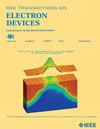Enhancing the Durability and Efficiency of Flexible Semi-Transparent Organic Solar Cells With Silver Mesh Electrode
IF 2.9
2区 工程技术
Q2 ENGINEERING, ELECTRICAL & ELECTRONIC
引用次数: 0
Abstract
The performance of organic solar cells (OSCs), particularly flexible semi-transparent OSCs (ST-OSCs), is often limited by the use of indium tin oxide (ITO) electrodes, which are prone to cracking under bending and thus compromise device performance. This study introduces a novel silver mesh electrode (Ag-mesh) as a substitute for ITO in ST-OSCs. The Ag-mesh electrodes demonstrated optimal performance at a thermal imprinting temperature of 130 °C, with minimal line breakage and preserved optoelectronic properties. Compared to ITO electrodes, ST-OSCs with Ag-mesh electrodes showed superior mechanical stability, retaining over 90% of their initial performance after 1000 bending cycles, and an impressive retention of nearly 87% of their initial power conversion efficiency (PCE). The devices based on Ag-mesh electrodes also exhibited higher fill factor (FF) and better light response, aligning with higher conductivity and transmittance of the Ag-mesh electrodes. This research offers a significant contribution to the field by providing a durable and efficient alternative to ITO electrodes in flexible ST-OSCs. The Ag-mesh electrodes not only match but exceed the performance of ITO electrodes in terms of efficiency and stability, marking a substantial step forward in the development of flexible and semi-transparent solar cell technology.用银网电极提高柔性半透明有机太阳能电池的耐用性和效率
有机太阳能电池(OSCs)的性能,特别是柔性半透明OSCs (ST-OSCs),通常受到使用氧化铟锡(ITO)电极的限制,这些电极在弯曲下容易开裂,从而影响器件性能。本研究介绍了一种新型银网状电极(Ag-mesh)作为ST-OSCs中ITO的替代品。ag网电极在130°C的热印迹温度下表现出最佳性能,具有最小的断线和保持光电性能。与ITO电极相比,带有Ag-mesh电极的ST-OSCs表现出优越的机械稳定性,在1000次弯曲循环后保持了90%以上的初始性能,并且令人印象深刻地保持了近87%的初始功率转换效率(PCE)。基于Ag-mesh电极的器件还表现出更高的填充因子(FF)和更好的光响应,这与Ag-mesh电极的高电导率和透光率一致。这项研究通过在柔性ST-OSCs中提供耐用和高效的ITO电极替代品,为该领域做出了重大贡献。Ag-mesh电极在效率和稳定性方面不仅达到甚至超过了ITO电极的性能,标志着柔性和半透明太阳能电池技术的发展向前迈出了实质性的一步。
本文章由计算机程序翻译,如有差异,请以英文原文为准。
求助全文
约1分钟内获得全文
求助全文
来源期刊

IEEE Transactions on Electron Devices
工程技术-工程:电子与电气
CiteScore
5.80
自引率
16.10%
发文量
937
审稿时长
3.8 months
期刊介绍:
IEEE Transactions on Electron Devices publishes original and significant contributions relating to the theory, modeling, design, performance and reliability of electron and ion integrated circuit devices and interconnects, involving insulators, metals, organic materials, micro-plasmas, semiconductors, quantum-effect structures, vacuum devices, and emerging materials with applications in bioelectronics, biomedical electronics, computation, communications, displays, microelectromechanics, imaging, micro-actuators, nanoelectronics, optoelectronics, photovoltaics, power ICs and micro-sensors. Tutorial and review papers on these subjects are also published and occasional special issues appear to present a collection of papers which treat particular areas in more depth and breadth.
 求助内容:
求助内容: 应助结果提醒方式:
应助结果提醒方式:


